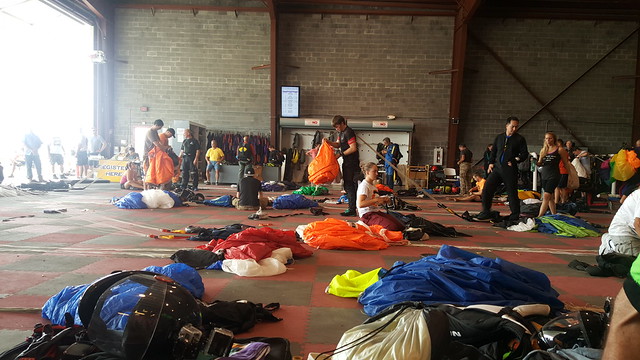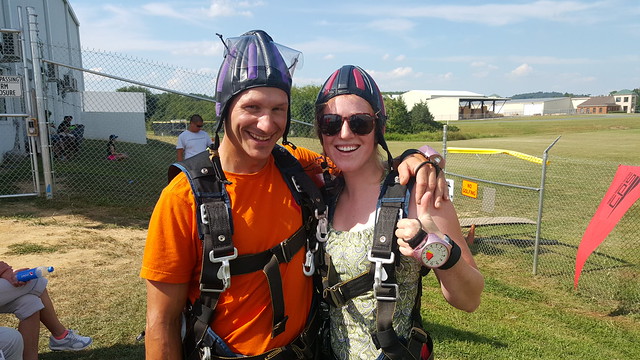Much
to my surprise, I didn't grow very nervous at all through the day's
events. There were some butterflies when I was finally able to meet my
tandem instructor and "suit up", but beyond the excitement in that
moment, I didn't experience any crazy burst of adrenaline -- something
that surprised me a lot! I experience a LOT more adrenaline release when
rafting on a Class V river in a class V rapid than I did all day
skydiving. Go figure.
When we arrived at Skydive Orange, we filled out paperwork (read: signing your name and initialing about 4 dozen times), watched a short video, paid up, and then waited and waited. They were having a skydiving festival this weekend (called a "boogie") which led to a lot more traffic in and around the hangar. It was very interesting to watch another group of adrenaline junkies go about their business though! As someone involved in multiple adrenaline junkie sports, I found it fascinating to observe folks go about their routines in what was a new-to-me atmosphere.
When we arrived at Skydive Orange, we filled out paperwork (read: signing your name and initialing about 4 dozen times), watched a short video, paid up, and then waited and waited. They were having a skydiving festival this weekend (called a "boogie") which led to a lot more traffic in and around the hangar. It was very interesting to watch another group of adrenaline junkies go about their business though! As someone involved in multiple adrenaline junkie sports, I found it fascinating to observe folks go about their routines in what was a new-to-me atmosphere.
 |
| Skydive Orange staffers and many others packing canopies and parachutes for their next jump |
Our group
received a bit of training on what to expect "in general" from one
fellow while we waited. This "training" took about 10 minutes and went
over the basics: when you leave the plane you should assume one position
with your body (arch your back and legs as much as you can while
keeping your hands on your harness) until the instructor taps your
shoulder at which point you will extend your arms away from your body
into the classic skydiving position you see on TV; upon landing, you
will need to pick your feet way, way up to get out of the way of the
instructor so they can "slide" you in safely. Further details on what we
would be doing would be provided later by our tandem instructor.
Planes took off every 20 minutes with loads of skydivers. These loads consisted of people who paid for tandems and those who were out participating in the sport for fun. Once you're licensed to jump and have your own gear, it's only $20 to jump. If the licensing and gear weren't so expensive for this sport I would TOTALLY get into it. (Expected startup cost before you get to the $20 jump phase is estimated ~$5-6k.)
I arrived at noon and was in a plane around 3p.
You straddle a bench in the plane. You shuffle tight against your instructor, nearly in their lap. If you're slated to be one of the last jumpers out of the plane, you'll have other people nearly in your lap. It seems to be the most efficient way to load a plane from what I could observe; everyone straddling a bench on either side of the aircraft, back to chest.
The flight to 14,000 feet took ~20
minutes. I watched the altimeter I'd been given as we climbed. 5k, 8k,
12k, and then we were there.
The door was rolled open
and the non-tandem jumpers started exiting one at a time as the cooler
14k air rushed into the aircraft.
Some jumpers hung onto the side of the plane for a second so they could grab their partner on the way down and try out some basic aerobatics with one another during the freefall. (The real experts had been doing up to 8-man formations on this day.)
Some jumpers hung onto the side of the plane for a second so they could grab their partner on the way down and try out some basic aerobatics with one another during the freefall. (The real experts had been doing up to 8-man formations on this day.)
My instructor had taken time during the
last 3,000 feet or so of the ascent to fasten my harness to his. When
you're jumping tandem you wear a body harness that is strapped to your
instructor's harness that has the parachute attached. So, technically, I
can boast that I jumped out of a plane at 14k feet without a parachute
-- but I was strapped to someone else who did have one!
My instructor and I were the last ones out of the plane on this jump.
I knew what to expect based on what he'd told me and what the other instructor had told our group. Hands down, the worst part was the waddle to the door. My instructor was a good 6" to 8" taller than me with longer legs. This made things so tricky! Couple that with the low ceiling in the aircraft and the wind tearing at you as you approached the door and it definitely made for a tricky time.
We made it to the door in short order though and I lined my toes up on the edge as I'd been instructed. The wind tore past me, the drone of the propeller and engine whirred in my ears. I took a moment to adjust myself to the foreign-to-me environment wondering when my instructor would throw us from the opening and into the abyss. My stomach wasn't clenched in fear or anticipation at all; instead, a surreal calmness had settled over me, something that became more and more pronounced as the plane climbed to altitude minutes before.
I felt the instructor begin to rock us forward and backwards as he held to either side of the door with his hands saying, "READY! *rock* SET! *rock* ...!!" And then we were freefalling.
The wind tore our bodies from the plane as we left the aircraft much like an apple core thrown from an open car window on the interstate.
We tipped sharply to the left, nearly upside down within the first two solid seconds of free fall before we adjusted. I arched my body sharply as I'd been told to do, my hands on my harness as my back and feet arched as much as I could muster. We'd been told to try to arch our heels around onto our instructors rear end. It took me a split second to adjust, but I felt my heels come into contact with his body and locked them there for the freefall.
I never closed my eyes and remember seeing the plane to my right and then above me at an odd angle to my falling body for a moment before we were righted and falling "straight".
Once righted and falling "straight", my instructor tapped my shoulder to signal me to extend my arms to further enjoy the remaining 55 seconds of freefall at 120mph. It was this moment when I realized that my face felt strained not because of the wind and gravity tearing at my body, but because I'd had a huge perma-grin plastered to my face since we'd left the aircraft.
I flexed my fingers in the wind, opened and closed my mouth, exalting in the surreal sensation of free falling.
Every 5 seconds or so, I glanced at my altimeter as my instructor had told me to do.
12,000. 10,000. 8,000...only 10 more seconds of freefall I thought to myself, and counted them slowly and silently in my head.
Then I could feel the instructor move slightly behind me and suddenly my rapid descent was jerked to a slower one as the parachute released and caught the air, my body jerking upward like a fish on a line pulled abruptly from the water.
My instructor loosened my harness away from his a little bit to make things more comfortable and maneuverable, "What's your altitude?" he queried me. I glanced at my altimeter, "A little over 5k, " I replied.
He had me look for our landing location which I had already noticed far below, and told me we were about a mile out. I baffled over this a moment and told him about how surreal it was to be looking at the landscape in real time in this manner. I'm so accustomed to looking at it on my mapping program! We had a short conversation about that and then he allowed me to help maneuver the parachute through the air.
Look left to clear your airspace, pull left, release slowly once you've achieved the turn radius you desire and straighten back up. Look right, clear your airspace, pull right, release. It reminded me a lot of my aids with the reins when riding horses or when pulling the release for a bow trap when trapping raptors.
We arched left and right through the air, completing a 360 degree circle a time or two before he reclaimed full control around 2,800 feet.
I was asked to practice my feet up for landing technique as he talked me through what he would do. He was confident we could have a standing landing if I listened to his instructions.
We circled around above the hangar, approaching from the left side of the landing area in a clockwise circle. "FEET UP, " I was told, and I lifted my feet up about waist high. "READY..." he cautioned me as we neared the ground at a higher rate of speed than you'd expect, "...NOW," he said, more for himself than me as I had zero control at this point when he altered the parachute slightly to slow our landing intensely at the last moment before we hit the ground. Much like a bird approaching a branch to land will flare its tail and wings a bit to alight softly on the branch, the parachute changed form to help us alight softly on the ground. "And STAND," my instructor finally told me when he was stable.
My face was aching something fierce from my permagrin at this point, but I just couldn't wipe it from my face.
I was released from my instructor's harness, and we exchanged a high five and a hug before he gathered up the parachute for the walk up to the hangar. He took a moment to tell me that I was the first person he'd ever had who actually hooked their heels onto his bum. They always instruct people to do that but no one ever does. He said my body position was great and I was "made for this sport".
I officially declare this 30 before 30 goal accomplished.
 |
| Thumbs up and permagrins for the longest time. Note the altimeter on my left hand. |


No comments:
Post a Comment